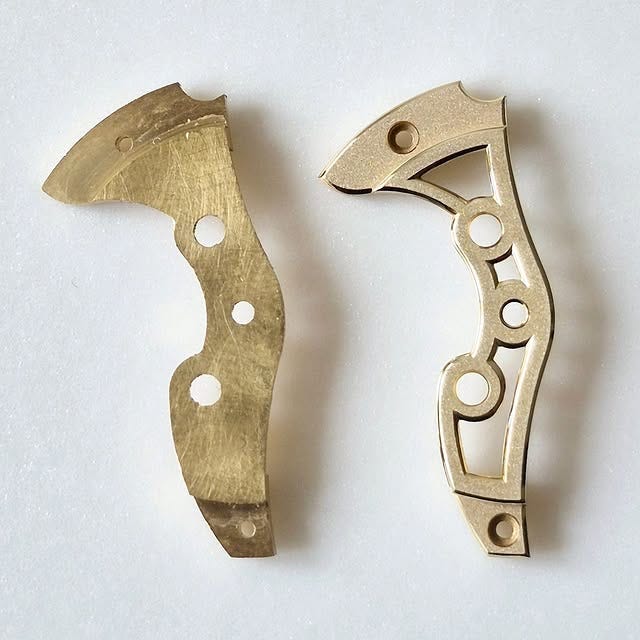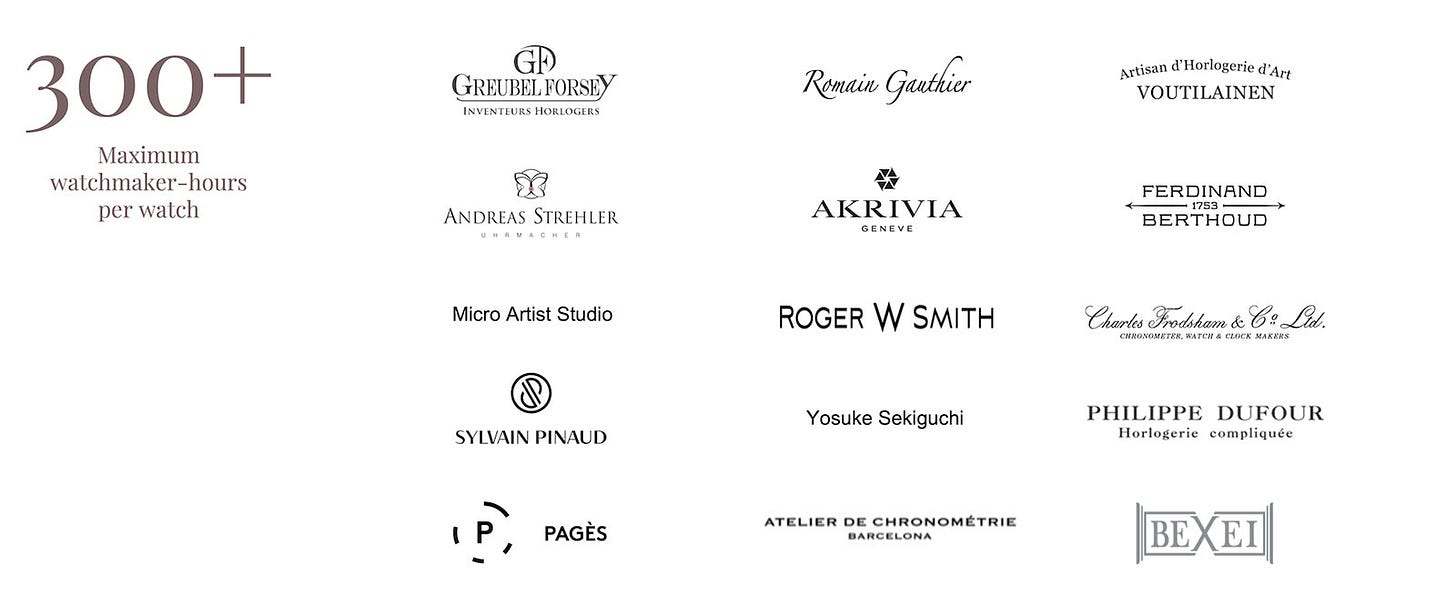The Hand-Finishing Fairy Tale
Precision Without Purpose Is Pointless
Last month, watchmaker Philippe Narbel posted a question on Instagram about bevelling and guilloché terminology, and on the face of it, the question seemed innocent enough. Then Doran Mitchell, a Vancouver-based watchmaker and machinist, left a comment explaining how sharp internal angles (“corners”) have been done by CNC for years, with just a bit of hand polish on top. He claimed that most alleged experts on the customer side can’t tell, and those on the manufacturing side obviously won’t tell.
Jack Forster then picked up the thread and I’d say he concluded Mitchell was probably right. The ship has supposedly sailed on sharp inner angles only being possible with literal hand finishing. This ought to matter to anyone spending five or six figures on watches marketed as “hand-made” because reality is more complicated and far less romantic than brands would have you believe.
Estimated reading time: 15 mins
Technical capabilities
CNC machines use rotating cutting tools called end mills, and because they rotate, they must have a physical radius. Logic will tell you, you can’t create a geometrically perfect sharp inner corner with a round, rotating tool. No sh1t. And so, brands and collectors have lived in this fantasy world as “proof” that sharp inner angles necessarily imply hand work.
The problem with this logic, is that you can create corners with radii so small that they’re essentially invisible to the naked eye. Modern end mills can be less than 0.2mm in diameter, and that means corner radii of 0.1mm i.e. a tenth of a millimetre. Who is going to spot this?
Plus, if you need even sharper corners than that, there’s EDM (Electrical Discharge Machining), also known as spark erosion or wire-EDM (although both are ultimately part of the “EDM group of activities”). I don’t have any desire to get super-technical here, but the point to take away is simple - there are techniques which can produce inner angles or corners with radii as small as 0.05mm.
That’s “sharp AF”, as the kids would say.
Aside from that, there are also tangential knife path tools i.e. non-rotating cutting tools which can create sharp corners too. This is the same principle as a rose engine, except it’s controlled by computer code instead of human hands.
“DKprecisionmechanics”, is a chap who claims to have spent 20 years doing CNC work for the watch industry, and he confirmed all of this in the comments section of Jack’s article which I linked above. He explains how he’s done sharp inner angles on 3-axis machines, and how he’s seen blanks arrive with perfectly prepared inward angles that needed no major filing whatsoever – just two bits of wood with abrasive papers and polishing.
Philippe Narbel himself, who worked for six years at Audemars Piguet including two years in hand finishing, acknowledged that “it’s no longer a rotary tool that does the work, but a cutting tool, much like a wood plane, that can produce perfect inward angles.”
Yet again, the takeaway here is that machines can do this stuff. Maybe not all machines, and maybe not easily, but it certainly seems to me, that not only can machines can do inner angles today, they seem to be getting better and this trend will only continue. To counter that, he’s bringing receipts to back up his claims:
His caption states (edited for clarity):
What does “hand made decoration” really mean?
It means that all the openworked area has been made with a hand saw (mine is 100 years old, perhaps my favourite tool ever), and that ALL bevels has been made by hand, without any help from a CNC machine.
For these bridges, we asked the supplier NOT to make bevels with their machines. We wanted, and we always will want, to do it totally by hand.
Now let’s park that for a moment, and explore some other avenues in this neighbourhood…
Doing the math
Back in November 2022, SJX published an analysis that provides further ammo for evaluating hand-finishing claims. He calculated the maximum possible watchmaker-hours per watch for over 50 brands using publicly available data about production numbers and staff counts.
At the very top, he placed Ferdinand Berthoud with 643 watchmaker-hours per watch. Brands producing fewer than five watches per employee per year averaged 834 watchmaker-hours per watch - see list above.
Next he had Lange and Journe in the 100-299 range (212 and 264 watchmaker-hours respectively). The “holy trinity” sat lower, with Patek at about 38 watchmaker-hours per watch, and AP at 73. Rolex, Omega, and Grand Seiko were somewhere between 3-6 watchmaker-hours per watch.
These numbers tell you what’s actually possible, and that you cannot claim extensive hand finishing when your production numbers and headcount suggest each watch receives 20 watchmaker-hours, at most. The mathematics simply will not work.
SJX’s analysis also explained how Patek employs 1,600 staff and produces about 68,000 watches annually, so when collectors wondered (at the time he posted it) why Patek’s new perpetual calendar lacked sharp inner angles, the answer was kinda obvious; less than 50 watchmaker-hours per watch means you have to ration the more expensive hand-finishing flourishes to the elite pieces only.
Gold rush
Every other day, I discover another new independent watchmaker launching a time-only watch for 50k or more. The formula has become predictable; they offer a limited run of 10-100 pieces, use a souscription model requiring upfront payment, and propose a waiting time of 1-2 years. This is all accompanied by lavish marketing about, you guessed it, hand-finishing or artisanal craft.
The more I think about it, it feels like some of the more recent indies’ success stories created a kind of “template”, and anyone with industry contacts is now aiming to replicate this sort of success. Some might be legit, and many others are opportunists who’ve figured out that “hand-made” will sell at a premium; and in the end, most enthusiasts lack the knowledge or access to verify any claims being made.
Now, activate your brain for a moment, and you will realise that a one or two-person operation claiming to produce 20-30 “fully hand-finished” watches annually, is making quite a preposterous claim. That’s 1,500+ watchmaker-hours per watch, assuming they work every single day with zero time for marketing, client relations, or basic admin.
When you ask about their workshop, they show you a finishing bench and maybe some vintage lathes. What they don’t show you are the CNC machines at their supplier making the raw movement components to a ‘nearly finished’ standard. They don’t talk about how many parts are coming from third-party manufacturers. The carefully curated Instagram posts show the romantic bits… filing, polishing, assembly… and they conveniently omit the industrial reality of modern component production we discussed at the beginning of this post.
With so many of these new “independents”, everything remains vague. They invoke the romantic language of hand-craft but avoid any details or specifics. How many staff do they employ? What are their actual skills? Which components do they make, versus buy? How many hours of actual hand-work actually go into finishing each watch? Does this even add value?
Crickets…





